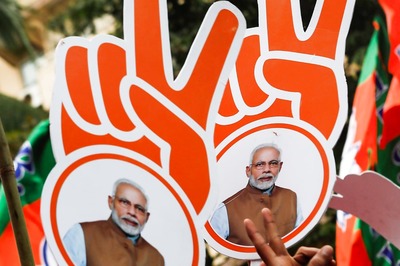
views
10 Signs a Stanley Cup is Fake
Improper Handle Position Fake Stanley cups often have their handles positioned lower than the handle on a real Stanley cup, as many TikTok users have shown. On most authentic Stanley products, the top of the handle is almost flush with (or touching) the stainless steel rim. A gap of one or two fingers’ width between the top of the handle and the shiny rim is a sign of a fake cup. Compare your Stanley cup with the images of the same product on Stanley’s official website to see where the handle should be positioned. Fake Stanley cups may also have loose handles with a thin gap where the top and bottom prongs of the handle connect with the side of the cup. Check the sturdiness of the handle by gently shaking the cup back and forth.
Spelling Errors Counterfeit products may have spelling errors in the product labels, logos, and other text or markings. Inspect your Stanley cup closely, comparing it to a Stanley purchased directly from the company or to pictures on the official Stanley website. Places to look include the Stanley logo on the surface of the cup and the text on the bottom of the cup.
Inaccurate Logos Fake Stanley products may have badly reproduced logos. Compare the Stanley logo on the side of your cup to pictures of the Stanley logo from the official website or to an authentic cup. Inspect the color and appearance of the Stan bear logo, the font used for the word “Stanley,” and the size of the word and the bear image. Look for underlined text on the bottom of the cup—Stanley does not underline text on products.
Missing Information If your Stanley cup does not have a logo on the side of the cup, or the etched Stan the bear on the middle of the top of the lid, this could be a sign it’s a fake. Most Stanley cups also have product information and the Stanley bear logo on the bottom of the cup, as well as an etched recycling symbol on the bottom of the inside of the cup. Text on the bottom (outside) of an authentic cup usually has the following text, although different sizes and versions may not have all of this information: “BPA free,” “Dishwasher safe,” “Do not microwave,” “Using straw with hot drinks may scald,” “Designed in Seattle WA,” and “Ethically manufactured in China - BC.” New Stanley cups also typically have a sticker on the bottom with a UPC (Universal Product Code), which is a bar code.
Uneven Proportions TikTok users who purchased fake Stanleys noticed the proportions between the metallic rim and the removable plastic lid were uneven compared to official Stanley product photos. Do a comparison between your cup and the same product on the Stanley website. Look to see if the lid or rim are too large or too small, especially in proportion to one another.
Light Weight Stanley lists the total weight of their cups, tumblers, and other products on their official website. Find the product page for the cup you purchased. Look at the bottom of the “Details & Specifications” section to find its weight in pounds. Weigh your Stanley cup on a kitchen scale and convert the measurement (if in grams or ounces) to pounds to compare. A much lighter cup indicates it’s not made from Stanley’s stainless steel—and is a fake Stanley product. Authentic 40 oz Stanley cups (without lids) usually weigh between 585-588 grams, while lids typically weigh between 75-76 grams.
Inconsistent Color and Finish Counterfeit goods tend to be of lower quality than legitimate products. Inspect your Stanley cup for a consistent color. Look closely to see if the color on the lower half of the cup matches the color of the upper half and the handle. Feel the cup to inspect its finish—is it rough, grainy, or easily scratched? That could be a sign it’s a fake Stanley cup. If you can, compare your Stanley’s color to the color of the authentic Stanley at the store to ensure they’re the same. You can also try to compare your Stanley to product photos on the Stanley website—although the authentic Stanley’s colors may appear different in photographs versus in real life.
Shallow Stan Bear Etching On the lid of Stanley cups, there is a FlowState™ 3-position lid. The center of the lid features an etching of Stanley mascot Stan, the mythical bear. On authentic Stanley cups, this etching is clear with crisp edges. Fake Stanley cups may have a shallow etching on the lid, or an inked-on image instead of an engraving. Feel and visually inspect the etching to check that it is clear and crisp.
Wrong Handle Screws Most Stanley cups include hexagon head screws that can be removed with an Allen wrench (also known as a hex key). If your cup has an unfamiliar screw, it could be a sign that it’s a fake—although older models and certain collaborations may use different screws. Missing screws are also a sign of either a counterfeit product or a manufacturing error.
Clear or Small Straw TikTok users and bloggers claim that a clear plastic straw is a sign of a fake Stanley cup. However, Stanley sells clear plastic straws. While many real Stanley cups come with colored, frosted straws, a clear straw is not a sure sign of a fake. However, straw size is important—authentic Stanley straws are sturdier and wider in diameter than your typical drinking straw.
Tips for Buying an Authentic Stanley Cup
Buy directly from Stanley or an authorized retailer. You can order real Stanley cups directly from Stanley on their official website. You can also use their store locator tool to find authorized retailers in your area. National chains like Target, DICK’s Sporting Goods, REI, and Lowe’s Home Improvement sell authentic Stanley products. Beware of scam websites imitating legitimate Stanley retailers. The Better Business Bureau issued a scam alert in 2023 when there was a rise in fake, shady websites selling Stanley cups that were fake or never delivered. Check the website’s URL before ordering to make sure it’s not an imitation website with typos, hyphens, or numbers that don’t belong—and avoid ordering from a link you clicked on social media. If you’re purchasing from a third-party seller on a marketplace like Amazon, eBay, or TikTok Shop, compare product images to the official Stanley website before purchasing. If you can’t find an identical product, or there are differences in the product description, this could be a sign it’s a fake Stanley product.
Avoid deals that are too good to be true. While Stanley cups occasionally go on sale and independent resellers may offer discounts, a price much lower than the price listed on the Stanley website is a red flag. Use your judgment when deciding to risk buying a low-priced Stanley from a third-party seller. If it feels too good to be true, it probably is.
Read product reviews before purchasing. This mostly applies when ordering from a third-party seller like Amazon or TikTok Shop, although you can also read reviews on Stanley’s website. See if other customers have complained about the products being fake. Also, beware of fake positive reviews. If the reviews are all from the same day, or all use similar language, they could have been written by the seller to trick people into buying their fake products.
Alternatives to Stanley Cups
Several brands sell tumblers and travel mugs similar to Stanley. These cups may come at a lower price point than a Stanley cup of the same size. While it’s tempting to purchase a Stanley cup dupe to save money while flaunting the same brand name, fake Stanley cups could have inferior quality and functionality. Consider the options below instead, which are from legitimate brands offering a similar look, size, and function as Stanley cups. Owala Stainless Steel Tumbler, 40 oz Hydro Flask Travel Tumbler, 40 oz Takeya Stainless Steel Tumbler, 40 oz HydroJug Traveler, 32 oz Simple Modern Tumbler, 40 oz YETI Rambler Tumbler, 35 oz OXO Strive XL Tumbler, 40 oz




















Comments
0 comment